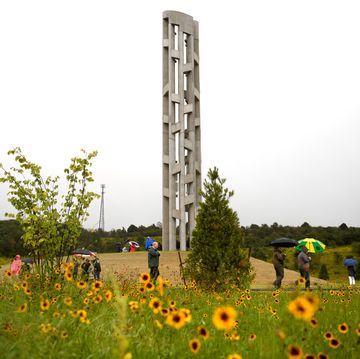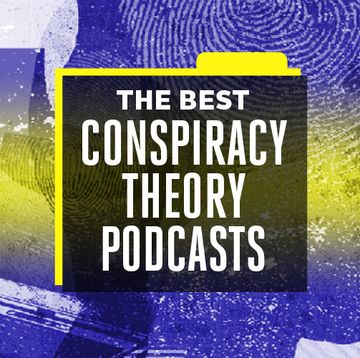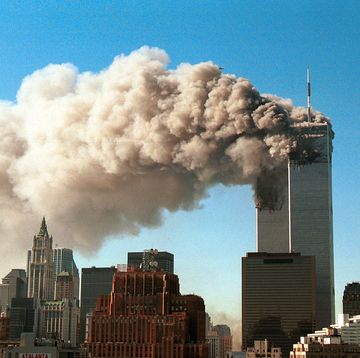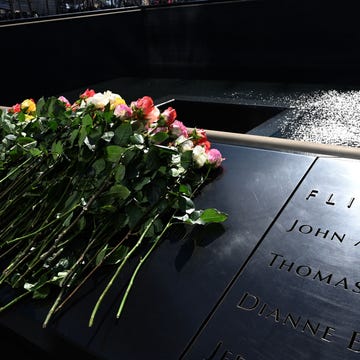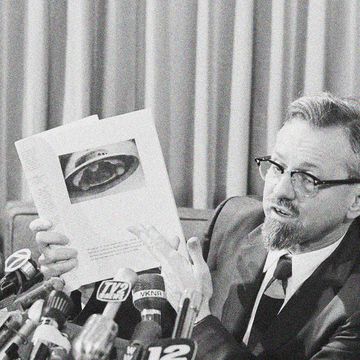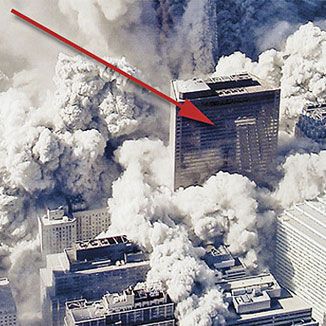PM first became interested in 9/11 conspiracy theories in the fall of 2004, when a series of advertisements appeared in The New York Times promoting the book Painful Questions, by Eric Hufschmid. The advertisements included a number of claims regarding the physical evidence of the attacks. If true, these claims might have cast doubt on the generally accepted account of 9/11. PM editor-in-chief James B. Meigs asked the magazine's senior staff to begin a preliminary investigation of these and other claims made by 9/11 conspiracy theorists in order to decide whether the topic would be appropriate for an article in Popular Mechanics.
Under the supervision of executive editor David Dunbar, the team looked into a wide range of 9/11 theories, and came up with a list of the most widely circulated claims involving tangible evidence. These included claims in the Hufschmid book, as well as assertions regarding the Pentagon and the crash of Flight 93. In a meeting a few days later, we decided that an in-depth investigation of these claims would be both a public service and an interesting story in the Popular Mechanics tradition. The decision was made by the editorial team alone; we received no outside mandate or encouragement to pursue this piece.
Did Popular Mechanics really have an open mind regarding the evidence?
Yes. Conspiracy theorists make a large number of claims that would have very troubling implications, if true. Our mission was to research those claims. If we found even a grain of truth behind any of them, it would have been a major story, which we wouldn't have hesitated to publish. On the other hand, if the claims turned out to be based on falsehoods, that too would be important information to convey to our readers.
Did you deliberately focus on some of the more ludicrous conspiracy claims in order to make the conspiracy community look ridiculous?
This objection surfaced within days after we published our original article: "Popular Mechanics Attacks Its '9/11 Lies' Straw Man," read the headline of an article by conspiracy theorist Jim Hoffman. His claim was that PM chose weak theories in order to discredit conspiracy theories in general. For example, he argued that the claim that seismic spikes were detected by Columbia University seismographs moments before each Twin Tower collapsed, was a "red herring." The claim about spikes originated in an article by Christopher Bollyn in the ultraright newspaper, American Free Press.
We agree that many conspiracist claims seem far-fetched. And we are aware that not all conspiracy theorists agree with each other as to which theories to take seriously. But we don't take sides in those debates. Instead, we simply did out best to include the most widely repeated claims at the time we published.
Interestingly, when the popular movie Loose Change appeared in 2005, it featured many of the same claims Hoffman had denounced, and included an image of the seismic spikes article in American Free Press. Although several theorists have criticized the film, Loose Change has generally been embraced by the conspiracy community. By the same token, the book Debunking 9/11 Debunking: An Answer to Popular Mechanics and Other Defenders of the Official Conspiracy Theory, by David Ray Griffin, quotes both Christopher Bollyn and Jim Hoffman as authoritative sources. We don't see any reason why Popular Mechanics should work harder than do leading conspiracy theorists themselves to make such claims appear coherent or consistent.
How did you pick the questions to investigate?
Sooner or later, every conspiracy theory comes down to some factual claim that, if true, would be at odds with the conventional account of September 11. For example, the claim that "jet fuel doesn't burn hot enough to melt steel" is used to suggest that the fires that followed weren't hot enough to cause the subsequent collapses. After all, if fire didn't bring down the towers, what did? Conspiracy theorists often repeat the refrain that "we're just asking questions." In practice they are eager to start supplying answers: The Towers were felled by bombs, thermite, secret demolition squads or some other cause. But what about those underlying factual claims? Are they accurate? We wanted to find out.
Our method was simple: Rather than try to tell the entire story of what did happen on September 11, we worked to assess the claims that conspiracy theorists themselves present as the foundations of their arguments. This is an important distinction often missed by conspiracy theorists who criticize PM's work. There is an enormous body of evidence--documents, engineering studies, forensic data, eyewitness accounts--that supports the mainstream view of September 11. Conspiracy theorists ignore or discount the vast bulk of this material and focus relentlessly on their small handful of anomalies. (Scientific American columnist Michael Shermer has an excellent piece on the fallacy of arguing from anomaly.)
We took conspiracy theorists at their word when they said they wanted to understand these anomalous facts. We dug as deeply as we could for answers. In every case that PM has investigated to date, the very evidence 9/11 conspiracy theorists use to support their arguments have turned out to be mistaken, misinterpreted or taken wildly out of context.
What makes you guys experts in all this stuff? I thought you were a car magazine.
We don't claim to be experts, only reporters. True, among PM's staff, contributors and advisors there are physicists, engineers, pilots and, yes, auto mechanics. But our job as journalists is to find expert sources, ask pertinent questions, and present their insights in an accessible manner. Our own backgrounds and experience might help us know what questions to ask, but we do not ask readers to accept any point based on our opinions. Our job is to gather the best, most accurate information we can find and present it to our readers.
So how did you determine whom to interview? What was the reporting process like?
We went straight to the sources--hundreds of them. Wherever the picture remained incomplete, we spoke with the people who could best respond to the rumors and fill in the gaps. How do we know it was aircraft wreckage found outside the Twin Towers on September 11, instead of some drone or missile? We spoke to the photographers and investigators who documented the jet wreckage and registration numbers. For insight into controlled demolition theories, we spoke to the largest demolition firms in the United States. We studied schematics and design elements for the World Trade Center, and spoke to leading professors and engineers to learn more about how the floors sagged and the steel warped in the fires.
Some critics claim that we "cherry-picked" sources who would be favorable to our "agenda." The fact is, for each question we studied, we simply approached the top experts in that particular field. The irony is that we were unable to find anyone with any degree of authority, in the public or private sector--first responders or university professors, engineers or flight instructors--who agreed with the claims made by 9/11 conspiracy theorists.
But why didn't you talk about U.S. foreign policy, corporate imperialism, oil empire, Bush family ties, Halliburton, the Mossad, the CIA, the Freemasons, the Illuminati or Opus Dei?
We're not trying to be flip here. Each of those supposed "root causes" has been cited by critics of PM's work. We didn't concern ourselves with the various geopolitical theories that conspiracy fans offer about September 11. We only looked at the physical evidence theorists cite in support of their theories. So far, that evidence has not held up to scrutiny.
PM is not a political magazine. We focus on science, technology, engineering, aviation and related topics. Every concrete, verifiable claim regarding the events of September 11 falls within our areas of historical expertise. The key questions include such issues as the performance of concrete and steel in fires, the technology and protocols of air traffic control and air defense, and the nature of jet aircraft crashes. All of those questions have answers, answers that are backed up by hard, tangible evidence--photos, transcripts, eyewitness accounts--as well as by expert opinion.
Did the government influence your editorial direction?
No.
Is PM staffer Benjamin Chertoff a cousin of Michael Chertoff, Secretary of the Department of Homeland Security?
As we explain in our book, it appears that they could be distant relatives. The connection, if any exists, dates back to the 19th century, before either family immigrated to the U.S. They have never met, and never spoken to one another. Michael Chertoff has never spoken with any member of the Popular Mechanics staff, nor with any member of Benjamin Chertoff's family.
The speculation concerning the supposed Chertoff connection is a good example of how conspiracy theorists often latch on to shreds of information, but get the details wrong. Ben Chertoff ran PM's research and fact-checking department at the time of the original magazine article, and conducted some reporting for the story. He was not the "senior editor," "head writer," or any of the other incorrect titles lofted by theorists. (Ben was later promoted to online editor, and recently left the magazine to pursue work as a freelance writer and producer.)
Moreover, Michael Chertoff was not secretary of Homeland Security at the time PM researched the original story. He was sworn in on Feb. 15, 2005, more than a month after the piece went to the printers.
Conspiracy theorists often present the supposed connection between Benjamin and Michael Chertoff as ipso facto proof of some sort of collaboration. But why would that be? There are nearly 30 people on the editorial staff of PM. Virtually none of them knew each other--or Ben--before coming to work here. So far, no one has explained to us how they believe a relatively junior magazine staffer could convince dozens of his colleagues to become complicit in a cover-up of one of the worst attacks in U.S. history.
Wasn't there a "brutal purge" of the PM staff just before the magazine began working on this project?
Sorry. Nothing so dramatic. After a nearly 20-year run at the helm, PM editor-in-chief Joe Oldham retired in June 2004. National Geographic Adventure executive editor James B. Meigs was hired to replace him. Meigs had a long history with PM, having previously written a column and feature articles for the magazine. Over the next few months, Meigs made a number of staff changes. Such changes are typical any time a new editor takes charge at a magazine--indeed, turnover is expected in any business when there is a change in leadership. Today, the staff at PM remains a mix of relatively new hires and long-time veterans. Several staffers have 20-plus years at the magazine.
Why won't you come "debate" the conspiracy theorists?
We have. (Click here for video.)
Generally, however, we have declined invitations to "debate" the events of September 11 with conspiracy theorists. We have done so for two reasons:
First, we think the notion of a debate misses the point. This magazine has no political stance on the levels of pilot certification achieved by the hijackers before September 11; we have no pundit-like opinion on the temperature at which steel begins to lose its strength, or ideology regarding seismic readings when the Twin Towers fell. Our work has focused on verifiable scientific and historical facts.
Secondly, in those cases where we have discussed these issues directly with conspiracy theorists--for example, during radio interviews--we found the exchanges less than productive. We don't believe that allowing ourselves to be subjected to shouting, personal invective and wild allegations advances anyone's understanding of the facts of September 11.
We prefer to publish our findings in print, where we can take the care to research each point fully and express each precisely. Anyone who takes issue with our findings is welcome to leave comments on our site, write their own web commentary or publish their own book. We take these criticisms seriously and have addressed them in our latest edition of Debunking 9/11 Myths.
Why does some of the information listed here (such as the fall of WTC 7) appear outdated?
This website lists the myths as originally presented in our March 2005 issue. We have since expanded these original 16 myths into 25, interviewing hundreds of sources, and published those findings in the latest edition of latest edition of Debunking 9/11 Myths. For a complete list of the myths covered, visit our About the Book page.





